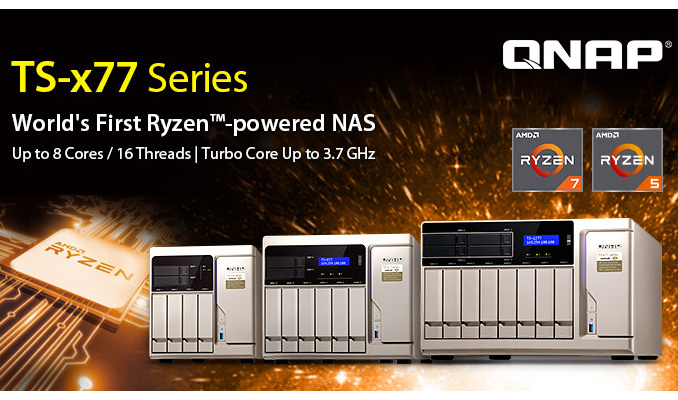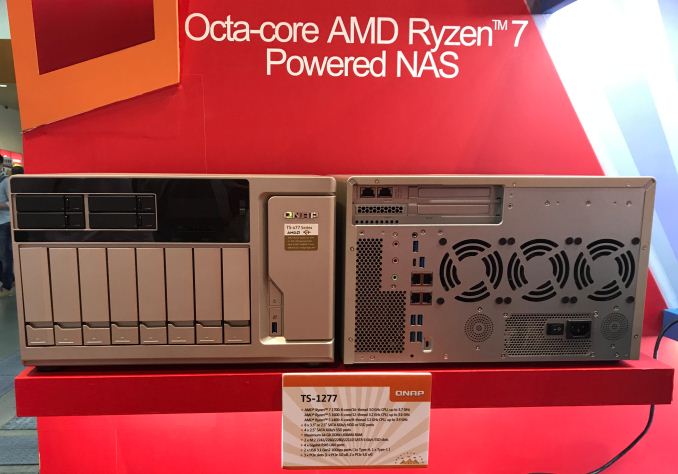QNAP Begins to Ship AMD Ryzen-Based TS-x77 Series NAS: 6, 8, 12 Bays
by Anton Shilov on November 3, 2017 3:00 PM EST
QNAP on Wednesday said that it had begun to ship its NAS devices based on AMD’s Ryzen processors. The new TS-677, TS-877 and TS-1277 NAS feature six, eight, or twelve hard drive bays and support SSD caching to maximize performance. The company positions the new NAS for various demanding applications, including VDI, private cloud, virtualization, containerized applications and so on.
QNAP introduced its TS-x77-series NAS at Computex in mid-2017 and became the first supplier of such products to adopt the AMD Ryzen platform. The company explained that high core count, strong integer performance, versatile PCIe support, AES-NI support, competitive pricing, and other factors made CPU a good choice for NAS. Integrated capabilities of the Ryzen platform enabled QNAP to support two M.2-22110 PCIe 3.0 x4 slots for caching SSDs, two PCIe 3.0 x4 slots as well as a PCIe 3.0 x8 slot for 10GbE/40GbE NICs, PCIe NVMe SSD, graphics and other expansion cards in all three models of the TS-x77 series.
The top-of-the-range 12-bay QNAP TS-1277 NAS is based on AMD’s eight-core Ryzen 7 1700 CPUs and come with 64 GB of DDR4 memory in order to handle various applications. Meanwhile, mid-range and entry-level models featuring 12, 8 or 6 bays use the six-core AMD Ryzen 5-1600 and come with 16 GB or 8 GB of memory (see the table below for specifications of the U.S. versions, for others it makes sense to check out the original news story from Computex). All the QNAP TS-x77-series NAS support RAID 50/60 as well as Qtier 2.0 IO Aware features for SSD tiered storage.
The new NAS will run QNAP’s QTS 4.3 operating system and therefore will support the same capabilities as other NAS from the manufacturer. In addition, the QTS 4.3 supports various specially designed applications. The TS-x77 devices are also virtualization ready for VMware, Citrix, Microsoft Hyper-V and Windows Server 2012 R2 environments with the support of iSER (iSCSI Over RDMA). The powerful CPUs inside enable the NAS to host virtual machines and run various applications.
| QNAP TS-1277, TS-877 and TS-677 Specifications for the U.S. Market | |||||||
| TS-1277- 1700-64G-US |
TS-1277- 1700-32G-US |
TS-1277- 1600-16G-US |
TS-877- 1700-16G-US |
TS-877- 1600-8G-US |
TS-677- 1600-8G-US |
||
| CPU | Model | Ryzen 7 1700 | Ryzen 5 1600 |
Ryzen 7 1700 |
Ryzen 5 1600 | ||
| Cores/ Threads |
8C/16T | 6C/12T | 8C/16T | 6C/12T | |||
| Freq. | 3 - 3.7 GHz | 3.2 - 3.6 GHz | 3 - 3.7 GHz | 3.2 - 3.6 GHz | |||
| L2 Cache | 4 MB | 3 MB | 4 MB | 3 MB | |||
| L3 Cache | 16 MB | 16 MB | 16 MB | 16 MB | |||
| TDP | 65 W | ||||||
| Encryption Acceleration | AES-NI | ||||||
| Memory | Speed | DDR4-2400, dual-channel | |||||
| Capacity | 64 GB (4×16 GB) | 16 GB (2×8 GB) |
8 GB (2×4 GB) |
16 GB (2×8 GB) |
8 GB (2×4 GB) |
||
| Bays | 8 × 3.5" 4 × 2.5" |
6 × 3.5" 2 × 2.5" |
4 × 3.5" 2 × 2.5" |
||||
| M.2 Slots | 2×M.2 slots (up to M.2-22110) | ||||||
| Storage interface | SATA 6 Gbps | ||||||
| Ethernet | 4×GbE, 10/40 GbE supported via add-in-cards | ||||||
| PCIe Slots | 1 × PCIe 3.0 x8 2 × PCIe 3.0 x4 |
||||||
| Audio | 2 speakers 1 × audio out 2 × audio in |
||||||
| USB | 1 × USB 3.1 Type-A 5 × USB 3.0 Type-A 1 × USB 3.1 Type-C |
||||||
| Other I/O | Monochrome backlit LCD display with Enter & Select buttons, 3.5 mm console port, voice allert, buzzer, etc. | ||||||
| Dimensions | Height | 234.6 mm / 9.23" | 231.9 mm / 9.13" | ||||
| Width | 369.9 mm / 14.56" | 292.8 mm / 11.53" | 224.9mm/8.9" | ||||
| Depth | 319.8 mm / 12.59" | ||||||
| PSU | 550 W | 450 W | 250 W | ||||
| OS | QNAP QTS 4.3 | ||||||
| MSRP | $3599 | $2699 | $2299 | $2299 | $1899 | $1699 | |
| Check Availability | Amazon Newegg |
Amazon Newegg |
Amazon Newegg |
Amazon Newegg |
Amazon Newegg |
Amazon Newegg |
|
Originally, QNAP promised to ship the TS-x77 series NAS sometimes in Q3, but then delayed them to November, so expect the products to be available from retailers in the coming couple of weeks. Given the positioning, the new TS-677, TS-877 and TS-1277 NAS from QNAP are not going to be cheap. The manufacturer did not reaffirm pricing of the new units in its recent press release, but based on claims made earlier this year, the most affordable TS-677 (Ryzen 5 1600, 8 GB DDR4, no drives) will retail for $1699, whereas the high-end TS-1277 (Ryzen 7 1700, 64 GB, no drives) will cost $3599. Actual specs and MSRPs may vary by region and fully-populated NAS will naturally cost more.
Related Reading:
- QNAP Launches TS-1277 NAS Powered by AMD's Ryzen CPUs: 12 Bays, 64 GB DDR4, Starts at $2,299
- QNAP at CES 2017 - Thunderbolt 3 and Xeon D NAS Units, Residential Gateways, and More
- Synology at CES 2017 - RT2600ac Wi-Fi Router, DSM Value Additions, and New Business NAS Units
- Netgear Expands ReadyNAS Lineup with Intel Denverton Atom Platform
Source: QNAP











23 Comments
View All Comments
Manch - Monday, November 6, 2017 - link
Because if the GPU is supported you can assign its use to various VM's in the same way you can assign X number of cores/ram/hdd, etc.UltraWide - Friday, November 3, 2017 - link
Pass-through GPU acceleration for VMs.Vatharian - Friday, November 3, 2017 - link
Right! through VT-d, you mean? Max one or two GPUs, and low-powered ones. I'm not convinced it's worth the effort, save maybe internal pcie adapter card with external PCI-Express backplane, that has separate power supply. While I run such setup myself (in a form of tower PC), I can see the appeal of having such system in a neat little box.Manch - Monday, November 6, 2017 - link
We have a graphics department which we can assign VM's that are allowed to utilize the GPU. Instead of building a physical graphics workstation for each user that may or may not depending on their role need all that power.Reflex - Friday, November 3, 2017 - link
Plex offers GPU acceleration for those of us using these as a media server (among other things).imaheadcase - Saturday, November 4, 2017 - link
These are historically terrible for such applications. The problem being obvious is that they require special builds only offered by QNAP or others. THey don't use regular OS, most NAS you buy from retail stores have custom "APP stores" that require updates to them.People have reported flat out broke media apps for months before a fix is issued.
tipoo - Monday, November 6, 2017 - link
It does? I thought it was pretty CPU bound, but did write GPU acceleration only for specific clients (Nvidia Shield TV so far)LouPetridish - Friday, November 3, 2017 - link
Here is their video: https://www.youtube.com/watch?v=vTGtjF7Xe3ASkip to 47 seconds if you want to know what the GPUs are for.
UralBas - Saturday, November 4, 2017 - link
Land assessment, astrophotography, engineering workstation, DCS or GIS multi user environments would benefit greatly from systems like these. Intel simply can't compete.Reality is that AMD has finally delivered a product that Intel should fear, as they aren't in the same league.
Those who fuse a lot of space for images or large datasets and some A/I environments will find this offering compelling. A single hour session for my needs means 20-200GB of data.
Gadgety - Sunday, November 5, 2017 - link
Interesting post. This type of info should have gone in the original piece.